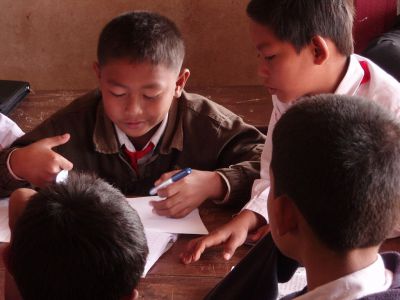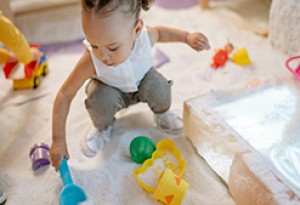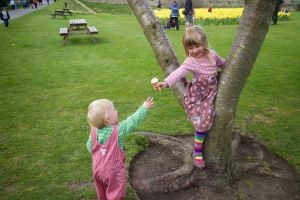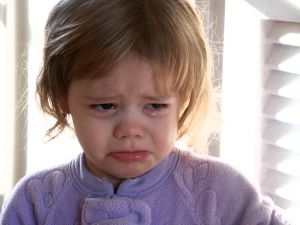Attention deficit hyperactivity disorder (ADHD) is a psychiatric disorder of the neurodevelopmental type in which there are significant problems of attention and/or hyperactivity and acting impulsively that are not appropriate for a person's age. These symptoms must begin by age six to twelve and be present for more than six months for a diagnosis to be made. In school-aged children the lack of focus may result in poor school performance. This article gives you info on ADHD in Children.
What is Attention Deficit Hyperactivity Disorder?
Attention deficit hyperactivity disorder (ADHD) is one of the most common childhood disorders and can continue through adolescence and adulthood. Symptoms include difficulty staying focused and paying attention, difficulty controlling behavior, and hyperactivity (over-activity).
ADHD has three subtypes:
Predominantly hyperactive-impulsive
- Most symptoms (six or more) are in the hyperactivity-impulsivity categories.
- Fewer than six symptoms of inattention are present, although inattention may still be present to some degree.
Predominantly inattentive
- The majority of symptoms (six or more) are in the inattention category and fewer than six symptoms of hyperactivity-impulsivity are present, although hyperactivity-impulsivity may still be present to some degree.
- Children with this subtype are less likely to act out or have difficulties getting along with other children. They may sit quietly, but they are not paying attention to what they are doing. Therefore, the child may be overlooked, and parents and teachers may not notice that he or she has ADHD.
Combined hyperactive-impulsive and inattentive
- Six or more symptoms of inattention and six or more symptoms of hyperactivity-impulsivity are present.
- Most children have the combined type of ADHD.
Treatments can relieve many of the disorder's symptoms, but there is no cure. With treatment, most people with ADHD can be successful in school and lead productive lives. Researchers are developing more effective treatments and interventions, and using new tools such as brain imaging, to better understand ADHD and to find more effective ways to treat and prevent it.
What are the Symptoms of ADHD in Children?
Inattention, hyperactivity, and impulsivity are the key behaviors of ADHD. It is normal for all children to be inattentive, hyperactive, or impulsive sometimes, but for children with ADHD, these behaviors are more severe and occur more often. To be diagnosed with the disorder, a child must have symptoms for 6 or more months and to a degree that is greater than other children of the same age.
Children who have symptoms of inattention may:
- Be easily distracted, miss details, forget things, and frequently switch from one activity to another.
- Have difficulty focusing on one thing.
- Become bored with a task after only a few minutes, unless they are doing something enjoyable.
- Have difficulty focusing attention on organizing and completing a task or learning something new.
- Have trouble completing or turning in homework assignments, often losing things (e.g., pencils, toys, assignments) needed to complete tasks or activities.
- Not seem to listen when spoken to.
- Daydream, become easily confused, and move slowly.
- Have difficulty processing information as quickly and accurately as others.
- Struggle to follow instructions.
Children who have symptoms of hyperactivity may:
- Fidget and squirm in their seats.
- Talk nonstop.
- Dash around, touching or playing with anything and everything in sight.
- Have trouble sitting still during dinner, school, and story time.
- Be constantly in motion.
- Have difficulty doing quiet tasks or activities.
Children who have symptoms of impulsivity may:
- Be very impatient.
- Blurt out inappropriate comments, show their emotions without restraint, and act without regard for consequences.
- Have difficulty waiting for things they want or waiting their turns in games.
- Often interrupt conversations or others' activities.
ADHD Can Be Mistaken for Other Problems
Parents and teachers can miss the fact that children with symptoms of inattention have the disorder because they are often quiet and less likely to act out. They may sit quietly, seeming to work, but they are often not paying attention to what they are doing. They may get along well with other children, compared with those with the other subtypes, who tend to have social problems. But children with the inattentive kind of ADHD are not the only ones whose disorders can be missed. For example, adults may think that children with the hyperactive and impulsive subtypes just have emotional or disciplinary problems.
What Causes ADHD?
Scientists are not sure what causes ADHD, although many studies suggest that genes play a large role. Like many other illnesses, ADHD probably results from a combination of factors. In addition to genetics, researchers are looking at possible environmental factors, and are studying how brain injuries, nutrition, and the social environment might contribute to ADHD.
Genes: Inherited from our parents, genes are the "blueprints" for who we are. Results from several international studies of twins show that ADHD often runs in families. Researchers are looking at several genes that may make people more likely to develop the disorder. Knowing the genes involved may one day help researchers prevent the disorder before symptoms develop. Learning about specific genes could also lead to better treatments.
Children with ADHD who carry a particular version of a certain gene have thinner brain tissue in the areas of the brain associated with attention. This NIMH research showed that the difference was not permanent, however, and as children with this gene grew up, the brain developed to a normal level of thickness. Their ADHD symptoms also improved.
Environmental factors: Studies suggest a potential link between cigarette smoking and alcohol use during pregnancy and ADHD in children. In addition, preschoolers who are exposed to high levels of lead, which can sometimes be found in plumbing fixtures or paint in old buildings, may have a higher risk of developing ADHD.
Brain injuries: Children who have suffered a brain injury may show some behaviors similar to those of ADHD. However, only a small percentage of children with ADHD have suffered a traumatic brain injury.
Sugar: The idea that refined sugar causes ADHD or makes symptoms worse is popular, but more research discounts this theory than supports it. In one study, researchers gave children foods containing either sugar or a sugar substitute every other day. The children who received sugar showed no different behavior or learning capabilities than those who received the sugar substitute. Another study in which children were given higher than average amounts of sugar or sugar substitutes showed similar results.
In another study, children who were considered sugar-sensitive by their mothers were given the sugar substitute aspartame, also known as Nutrasweet. Although all the children got aspartame, half their mothers were told their children were given sugar, and the other half were told their children were given aspartame. The mothers who thought their children had gotten sugar rated them as more hyperactive than the other children and were more critical of their behavior, compared to mothers who thought their children received aspartame.
Food additives: Recent British research indicates a possible link between consumption of certain food additives like artificial colors or preservatives, and an increase in activity. Research is under way to confirm the findings and to learn more about how food additives may affect hyperactivity.
How is ADHD diagnosed?
Children mature at different rates and have different personalities, temperaments, and energy levels. Most children get distracted, act impulsively, and struggle to concentrate at one time or another. Sometimes, these normal factors may be mistaken for ADHD. ADHD symptoms usually appear early in life, often between the ages of 3 and 6, and because symptoms vary from person to person, the disorder can be hard to diagnose. Parents may first notice that their child loses interest in things sooner than other children, or seems constantly "out of control." Often, teachers notice the symptoms first, when a child has trouble following rules, or frequently "spaces out" in the classroom or on the playground.
No single test can diagnose a child as having ADHD. Instead, a licensed health professional needs to gather information about the child, and his or her behavior and environment. A family may want to first talk with the child's paediatrician. Some pediatricians can assess the child themselves, but many will refer the family to a mental health specialist with experience in childhood mental disorders such as ADHD. The pediatrician or mental health specialist will first try to rule out other possibilities for the symptoms. For example, certain situations, events, or health conditions may cause temporary behaviors in a child that seem like ADHD.
Between them, the referring paediatrician and specialist will determine if a child:
- Is experiencing undetected seizures that could be associated with other medical conditions.
- Has a middle ear infection that is causing hearing problems.
- Has any undetected hearing or vision problems.
- Has any medical problems that affect thinking and behaviour.
- Has any learning disabilities.
- Has anxiety or depression, or other psychiatric problems that might cause ADHD-like symptoms.
- Has been affected by a significant and sudden change, such as the death of a family member, a divorce, or parent's job loss.
A specialist will also check school and medical records for clues, to see if the child's home or school settings appear unusually stressful or disrupted, and gather information from the child's parents and teachers. Coaches, babysitters, and other adults who know the child well also may be consulted.
The specialist also will ask:
- Are the behaviours excessive and long-term, and do they affect all aspects of the child's life?
- Do they happen more often in this child compared with the child's peers?
- Are the behaviours a continuous problem or a response to a temporary situation?
- Do the behaviours occur in several settings or only in one place, such as the playground, classroom, or home?
The specialist pays close attention to the child's behaviour during different situations. Some situations are highly structured, some have less structure. Others would require the child to keep paying attention. Most children with ADHD are better able to control their behaviors in situations where they are getting individual attention and when they are free to focus on enjoyable activities. These types of situations are less important in the assessment. A child also may be evaluated to see how he or she acts in social situations, and may be given tests of intellectual ability and academic achievement to see if he or she has a learning disability.
Finally, if after gathering all this information the child meets the criteria for ADHD, he or she will be diagnosed with the disorder.
How is ADHD treated?
Currently available treatments focus on reducing the symptoms of ADHD and improving functioning. Treatments include medication, various types of psychotherapy, education or training, or a combination of treatments.
Medications
The most common type of medication used for treating ADHD is called a "stimulant." Although it may seem unusual to treat ADHD with a medication considered a stimulant, it actually has a calming effect on children with ADHD. Many types of stimulant medications are available. A few other ADHD medications are non-stimulants and work differently than stimulants. For many children, ADHD medications reduce hyperactivity and impulsivity and improve their ability to focus, work, and learn. Medication also may improve physical coordination.
However, a one-size-fits-all approach does not apply for all children with ADHD. What works for one child might not work for another. One child might have side effects with a certain medication, while another child may not. Sometimes several different medications or dosages must be tried before finding one that works for a particular child. Any child taking medications must be monitored closely and carefully by caregivers and doctors.
Stimulant medications come in different forms, such as a pill, capsule, liquid, or skin patch. Some medications also come in short-acting, long-acting, or extended release varieties. In each of these varieties, the active ingredient is the same, but it is released differently in the body. Long-acting or extended release forms often allow a child to take the medication just once a day before school, so they don't have to make a daily trip to the school nurse for another dose. Parents and doctors should decide together which medication is best for the child and whether the child needs medication only for school hours or for evenings and weekends, too.
What are the Side Effects of Stimulant Medications?
The most commonly reported side effects are decreased appetite, sleep problems, anxiety, and irritability. Some children also report mild stomachaches or headaches. Most side effects are minor and disappear over time or if the dosage level is lowered.
- Decreased appetite: Be sure your child eats healthy meals. If this side effect does not go away, talk to your child's doctor. Also talk to the doctor if you have concerns about your child's growth or weight gain while he or she is taking this medication.
- Sleep problems: If a child cannot fall asleep, the doctor may prescribe a lower dose of the medication or a shorter-acting form. The doctor might also suggest giving the medication earlier in the day, or stopping the afternoon or evening dose. Adding a prescription for a low dose of an antidepressant or a blood pressure medication called clonidine sometimes helps with sleep problems. A consistent sleep routine that includes relaxing elements like warm milk, soft music, or quiet activities in dim light, may also help.
- Less common side effects: A few children develop sudden, repetitive movements or sounds called tics. These tics may or may not be noticeable. Changing the medication dosage may make tics go away. Some children also may have a personality change, such as appearing "flat" or without emotion. Talk with your child's doctor if you see any of these side effects.
Are Stimulant Medications Safe?
Under medical supervision, stimulant medications are considered safe. Stimulants do not make children with ADHD feel high, although some kids report feeling slightly different or "funny." Although some parents worry that stimulant medications may lead to substance abuse or dependence, there is little evidence of this.
FDA Warning on Possible Rare Side Effects
In 2007, the FDA required that all makers of ADHD medications develop Patient Medication Guides that contain information about the risks associated with the medications. The guides must alert patients that the medications may lead to possible cardiovascular (heart and blood) or psychiatric problems. The agency undertook this precaution when a review of data found that ADHD patients with existing heart conditions had a slightly higher risk of strokes, heart attacks, and/or sudden death when taking the medications.
The review also found a slight increased risk, about 1 in 1,000, for medication-related psychiatric problems, such as hearing voices, having hallucinations, becoming suspicious for no reason, or becoming manic (an overly high mood), even in patients without a history of psychiatric problems. The FDA recommends that any treatment plan for ADHD include an initial health history, including family history, and examination for existing cardiovascular and psychiatric problems.
One ADHD medication, the non-stimulant atomoxetine (Strattera), carries another warning. Studies show that children and teenagers who take atomoxetine are more likely to have suicidal thoughts than children and teenagers with ADHD who do not take it. If your child is taking atomoxetine, watch his or her behaviour carefully. A child may develop serious symptoms suddenly, so it is important to pay attention to your child's behaviour every day. Ask other people who spend a lot of time with your child to tell you if they notice changes in your child's behaviour. Call a doctor right away if your child shows any unusual behaviour. While taking atomoxetine, your child should see a doctor often, especially at the beginning of treatment, and be sure that your child keeps all appointments with his or her doctor.
Do Medications Cure ADHD?
Current medications do not cure ADHD. Rather, they control the symptoms for as long as they are taken. Medications can help a child pay attention and complete schoolwork. It is not clear, however, whether medications can help children learn or improve their academic skills. Adding behavioural therapy, counselling, and practical support can help children with ADHD and their families to better cope with everyday problems. Research funded by the National Institute of Mental Health (NIMH) has shown that medication works best when treatment is regularly monitored by the prescribing doctor and the dose is adjusted based on the child's needs.
Psychotherapy
Different types of psychotherapy are used for ADHD. Behavioural therapy aims to help a child change his or her behaviour. It might involve practical assistance, such as help organizing tasks or completing schoolwork, or working through emotionally difficult events. Behavioural therapy also teaches a child how to monitor his or her own behaviour. Learning to give oneself praise or rewards for acting in a desired way, such as controlling anger or thinking before acting, is another goal of behavioural therapy. Parents and teachers also can give positive or negative feedback for certain behaviors. In addition, clear rules, chore lists, and other structured routines can help a child control his or her behavior.
Therapists may teach children social skills, such as how to wait their turn, share toys, ask for help, or respond to teasing. Learning to read facial expressions and the tone of voice in others, and how to respond appropriately can also be part of social skills training.
How can parents help?
Children with ADHD need guidance and understanding from their parents and teachers to reach their full potential and to succeed in school. Before a child is diagnosed, frustration, blame, and anger may have built up within a family. Parents and children may need special help to overcome bad feelings. Mental health professionals can educate parents about ADHD and how it impacts a family. They also will help the child and his or her parents develop new skills, attitudes, and ways of relating to each other.
Parenting skills training helps parents learn how to use a system of rewards and consequences to change a child's behavior. Parents are taught to give immediate and positive feedback for behaviours they want to encourage, and ignore or redirect behaviours they want to discourage. In some cases, the use of "time-outs" may be used when the child's behaviour gets out of control. In a time-out, the child is removed from the upsetting situation and sits alone for a short time to calm down.
Parents are also encouraged to share a pleasant or relaxing activity with the child, to notice and point out what the child does well, and to praise the child's strengths and abilities. They may also learn to structure situations in more positive ways. For example, they may restrict the number of playmates to one or two, so that their child does not become overstimulated. Or, if the child has trouble completing tasks, parents can help their child divide large tasks into smaller, more manageable steps. Also, parents may benefit from learning stress-management techniques to increase their own ability to deal with frustration, so that they can respond calmly to their child's behaviour.
Sometimes, the whole family may need therapy. Therapists can help family members find better ways to handle disruptive behaviors and to encourage behavior changes. Finally, support groups help parents and families connect with others who have similar problems and concerns. Groups often meet regularly to share frustrations and successes, to exchange information about recommended specialists and strategies, and to talk with experts.
Tips to Help Kids Stay Organized and Follow Directions
- Schedule: Keep the same routine every day, from wake-up time to bedtime. Include time for homework, outdoor play, and indoor activities. Keep the schedule on the refrigerator or on a bulletin board in the kitchen. Write changes on the schedule as far in advance as possible.
- Organize everyday items: Have a place for everything, and keep everything in its place. This includes clothing, backpacks, and toys.
- Use homework and notebook organizers: Use organizers for school material and supplies. Stress to your child the importance of writing down assignments and bringing home the necessary books.
- Be clear and consistent: Children with ADHD need consistent rules they can understand and follow.
- Give praise or rewards when rules are followed: Children with ADHD often receive and expect criticism. Look for good behavior, and praise it.
What conditions can coexist with ADHD?
Some children with ADHD also have other illnesses or conditions. For example, they may have one or more of the following:
- A learning disability: A child in preschool with a learning disability may have difficulty understanding certain sounds or words or have problems expressing himself or herself in words. A school-aged child may struggle with reading, spelling, writing, and math.
- Oppositional defiant disorder: Kids with this condition, in which a child is overly stubborn or rebellious, often argue with adults and refuse to obey rules.
- Conduct disorder: This condition includes behaviours in which the child may lie, steal, fight, or bully others. He or she may destroy property, break into homes, or carry or use weapons. These children or teens are also at a higher risk of using illegal substances. Kids with conduct disorder are at risk of getting into trouble at school or with the police.
- Anxiety and depression: Treating ADHD may help to decrease anxiety or some forms of depression.
- Bipolar disorder: Some children with ADHD may also have this condition in which extreme mood swings go from mania (an extremely high elevated mood) to depression in short periods of time.
- Tourette syndrome: Very few children have this brain disorder, but among those who do, many also have ADHD. Some people with Tourette syndrome have nervous tics and repetitive mannerisms, such as eye blinks, facial twitches, or grimacing. Others clear their throats, snort, or sniff frequently, or bark out words inappropriately. These behaviours can be controlled with medication.
ADHD also may coexist with a sleep disorder, bed-wetting, substance abuse, or other disorders or illnesses.
Recognizing ADHD symptoms and seeking help early will lead to better outcomes for both affected children and their families.
How can I Work with my Child’s School?
If you think your child has ADHD, or a teacher raises concerns, you may be able to request that the school conduct an evaluation to determine whether he or she qualifies for special education services.
Start by speaking with your child's teacher, school counsellor, or the school's student support team, to begin an evaluation. Also, each state has a Parent Training and Information Center and a Protection and Advocacy Agency that can help you get an evaluation. A team of professionals conducts the evaluation using a variety of tools and measures. It will look at all areas related to the child's disability.
Once your child has been evaluated, he or she has several options, depending on the specific needs. If special education services are needed and your child is eligible under the Individuals with Disabilities Education Act, the school district must develop an "individualized education program" specifically for your child within 30 days.
If your child is considered not eligible for special education services—and not all children with ADHD are eligible—he or she still can get "free appropriate public education," available to all public-school children with disabilities under Section 504 of the Rehabilitation Act of 1973, regardless of the nature or severity of the disability. (please note that this info is for US. Visit Heath Insite for more information on ADHD in Australia.)
Transitions can be difficult. Each school year brings a new teacher and new schoolwork, a change that can be especially hard for a child with ADHD who needs routine and structure. Consider telling the teachers that your child has ADHD when he or she starts school or moves to a new class. Additional support will help your child deal with the transition.
What efforts are under way to improve Treatment?
This is an exciting time in ADHD research. The expansion of knowledge in genetics, brain imaging, and behavioural research is leading to a better understanding of the causes of the disorder, how to prevent it, and how to develop more effective treatments for all age groups.
NIMH has studied ADHD treatments for school-aged children in a large-scale, long-term study called the Multimodal Treatment Study of Children with ADHD (MTA study). NIMH also funded the Preschoolers with ADHD Treatment Study (PATS), which involved more than 300 preschoolers who had been diagnosed with ADHD. The study found that low doses of the stimulant methylphenidate are safe and effective for preschoolers, but the children are more sensitive to the side effects of the medication, including slower than average growth rates. Therefore, preschoolers should be closely monitored while taking ADHD medications.
PATS is also looking at the genes of the preschoolers, to see if specific genes affected how the children responded to methylphenidate. Future results may help scientists link variations in genes to differences in how people respond to ADHD medications. For now, the study provides valuable insights into ADHD.
Other NIMH-sponsored clinical trials on children and adults with ADHD are under way. In addition, NIMH-sponsored scientists continue to look for the biological basis of ADHD, and how differences in genes and brain structure and function may combine with life experiences to produce the disorder.
If you believe your child is showing signs of Attention Deficit Hyperactivity Disorder (ADHD), please consult with your doctor.
References
http://www.nimh.nih.gov/health/publications/attention-deficit-hyperactivity-disorder/index.shtml







 Working as a childcare professional can be a challenge especially when dealing with behavioural problems which may arise. The techniques we use when dealing with
Working as a childcare professional can be a challenge especially when dealing with behavioural problems which may arise. The techniques we use when dealing with There are different types of behaviour that children can display and sometimes it can be hard to manage, especially if a child is having behavioural
There are different types of behaviour that children can display and sometimes it can be hard to manage, especially if a child is having behavioural As a parent, your behavioural expectations of your child can be higher than what is actually developmentally appropriate for your child's age.
As a parent, your behavioural expectations of your child can be higher than what is actually developmentally appropriate for your child's age.
 As Educators, there will be many instances where you will need to write about a child's behaviour. For a behaviour management plan, assessments, half-yearly or
As Educators, there will be many instances where you will need to write about a child's behaviour. For a behaviour management plan, assessments, half-yearly or As Educators when communicating with Parents (through verbal or non-verbal communication), there will be times where we need to discuss issues or concerns that may
As Educators when communicating with Parents (through verbal or non-verbal communication), there will be times where we need to discuss issues or concerns that may Challenging Behaviour is when a child does something that hurts themselves and/or other people.
Challenging Behaviour is when a child does something that hurts themselves and/or other people.
 As part of your child's development it is normal for your child to have anxiety and fears. A baby commonly shows a fearful sign to
As part of your child's development it is normal for your child to have anxiety and fears. A baby commonly shows a fearful sign to It's always difficult to bring up behavioural issues with parents, it can be nerve wrecking to tell a parent that their child misbehaves but that
It's always difficult to bring up behavioural issues with parents, it can be nerve wrecking to tell a parent that their child misbehaves but that All children deal with anger on a daily basis. Thinking about it as a child, there is a lot to be angry about. Elder people
All children deal with anger on a daily basis. Thinking about it as a child, there is a lot to be angry about. Elder people It is important to understand that your child behaviour problems could not just be from attention seeking. There are many factors to take into consideration
It is important to understand that your child behaviour problems could not just be from attention seeking. There are many factors to take into consideration


